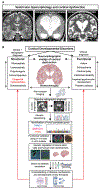Brain ventricles as windows into brain development and disease
- PMID: 34990576
- PMCID: PMC9212067
- DOI: 10.1016/j.neuron.2021.12.009
Brain ventricles as windows into brain development and disease
Abstract
Dilation of the fluid-filled cerebral ventricles (ventriculomegaly) characterizes hydrocephalus and is frequently seen in autism and schizophrenia. Recent work suggests that the genomic study of congenital hydrocephalus may be unexpectedly fertile ground for revealing insights into neural stem cell regulation, human cerebrocortical development, and pathogenesis of neuropsychiatric disease.
Keywords: CH; CSF; NSC; brain ventricle; cerebrospinal fluid; congenital hydrocephalus; genomics; neural development; neural stem cell; neurodevelopmental disorders.
Copyright © 2021 Elsevier Inc. All rights reserved.
Conflict of interest statement
Declaration of interests D.H.G. and C.A.W. are members of the Neuron advisory board. The other authors declare no competing interests.
Figures

References
-
- DeSpenza T Jr., Carlson M, Panchagnula S, Robert S, Duy PQ, Mermin-Bunnell N, Reeves BC, Kundishora A, Elsamadicy AA, Smith H, et al. (2021). PTEN mutations in autism spectrum disorder and congenital hydrocephalus: developmental pleiotropy and therapeutic targets. Trends Neurosci. 44, 961–976. - PMC - PubMed
-
- Notaras M, Lodhi A, Dündar F, Collier P, Sayles NM, Tilgner H, Greening D, and Colak D (2021). Schizophrenia is defined by cell-specific neuropathology and multiple neurodevelopmental mechanisms in patient-derived cerebral organoids. Mol. Psychiatry Published online November 12, 2021. 10.1038/s41380-021-01316-6. - DOI - PMC - PubMed
-
- Pang D, and Altschuler E (1994). Low-pressure hydrocephalic state and viscoelastic alterations in the brain. Neurosurgery 35, 643–655, discussion 655–656. - PubMed
Publication types
MeSH terms
Grants and funding
LinkOut - more resources
Full Text Sources
Medical

